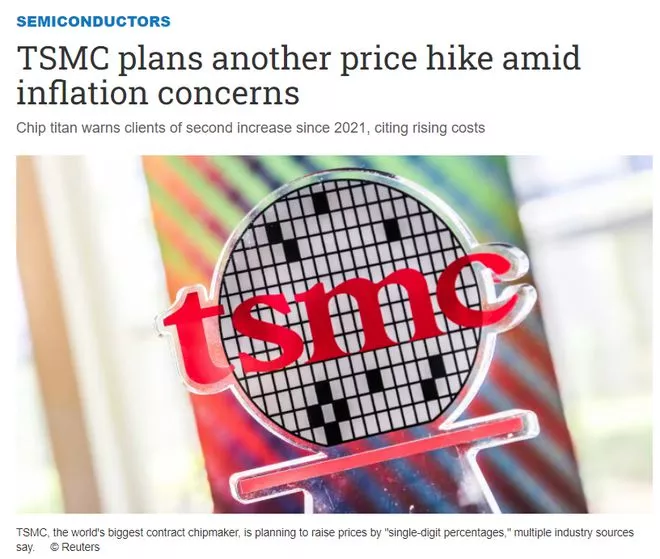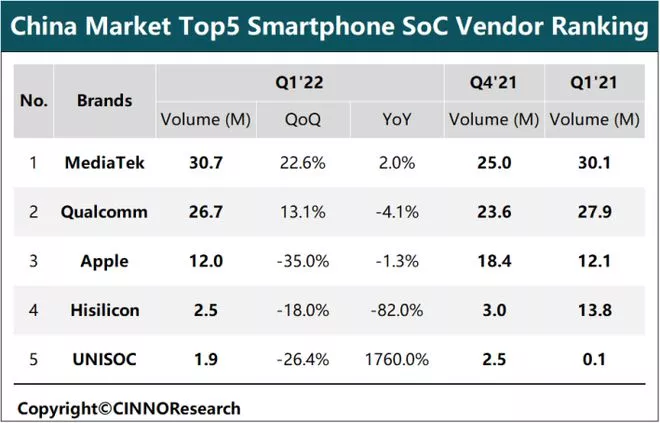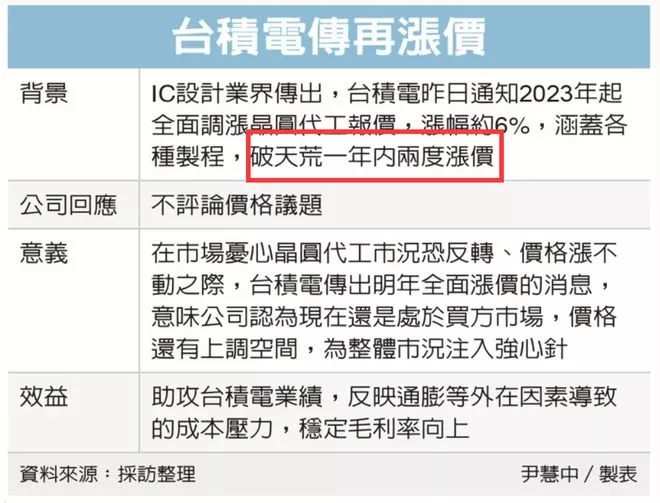TSMC, as a global foundry leader, used to be famous for "few price increases". However, under the pressure of global inflation and the need for huge funds for large-scale production expansion, the company once again informed customers that it would raise the prices of all processes. This is also the second time TSMC has raised its price in a year, which has shocked the Japanese media and called it "unprecedented". At the same time, it has also disturbed the industry.
Just as TSMC's price rises again, the terminal demand downstream of semiconductors such as smart phones and personal computers is showing a downturn. People on the island speculated that under the background of lower demand than last year, the price increase of TSMC should focus on non consumer electronics fields such as high-performance computing and vehicle chips, which is also a relatively clear area expected in the coming year.
For the industry leader to take the lead in raising prices, observer network also contacted SMIC international and Yuexin semiconductor, a large domestic wafer foundry. Among them, SMIC International did not comment on the price rise, while insiders of Yuexin semiconductor admitted that "the price rise is a common phenomenon in the industry, but it will be within a reasonable range". They also said that the impact of the domestic epidemic is small and the current production is normal.

Screenshot of Nikkei Asia Review Report
On May 10, Nikkei Asia quoted people familiar with the matter as saying that TSMC is planning to raise the price of wafer foundry business again. At present, it has begun to notify customers on the grounds that inflationary pressure has led to the rise of production costs such as parts, raw materials and freight, and to ensure the funds for large-scale expansion of production capacity.
According to several relevant sources, the price increase of TSMC will cover all manufacturing processes, including advanced and mature processes, as well as all product lines from high-end processors, various sensors, drive chips to power management chips. It is estimated that the price increase range is about "single digit", about 5% - 8%. According to the communication between TSMC and customers, this price increase measure is expected to be implemented in January 2023.
A person familiar with the matter quoted by Japanese media said that TSMC's advance notice is to provide customers with some buffer to prepare for price adjustment, and the company's price rise is to cope with rising costs and solve the huge capital problem required for historical capacity expansion. Another person familiar with the matter said that in view of the slowing demand for terminal products such as smartphones and personal computers, it may be difficult for customers to fully accept TSMC's price increase plan. "This may work for high-end chips, but it may be difficult for customers to accept mature processes".
Recently, affected by the conflict between Russia and Ukraine, repeated domestic epidemics, global inflationary pressure and other factors, the demand of the terminal market and the purchasing power of consumers have shown a downward trend. According to the data released by canalys, a market research organization, in the first quarter of 2022, the global shipment of smart phones was 311 million, a year-on-year decrease of 11%; According to the data released by strategy analytics, global notebook computer shipments fell by 7% year-on-year in the first quarter of 2022.
The weak terminal market is bound to drag down upstream parts suppliers.
According to the data released by cinno research, in the first quarter of 2022, the shipment of smart phone SOC in Chinese Mainland market was about 74.39 million, a year-on-year decrease of 14.4%. In March, the single month shipment fell by as much as 24.7% year-on-year and 14.6% month on month; In the same period, about 152 million AMOLED smart phone panels were shipped worldwide, down 8.0% from the same period last year and 28.4% from the fourth quarter of last year.
"In the second quarter, due to the superposition of multiple factors, the terminal demand continued to be sluggish. After reducing the annual target at the beginning of the year, the major mobile phone brands continued to revise this year's shipment. At present, the annual shipment target has been reduced by more than 10% compared with the beginning of the year." Cinno research analyst told observer.

Chart source of SOC shipments of smart phones in Chinese Mainland market in the first quarter of 2022: cinno research
Downstream demand is sluggish, but the cost of production side continues to rise. At the end of March this year, Liu Deyin, chairman of TSMC, publicly said that the costs of parts and materials are rising sharply, pushing up the production costs of technology enterprises and chip manufacturers. This pressure may eventually be passed on to consumers. At the same time, TSMC continues to make huge capital expenditure. It will invest US $100 billion to expand production capacity by 2023 and spend US $40-44 billion this year.
In this context, this price increase is the second price increase of TSMC in a year.
Taiwan's "Economic Daily" described the move as "unprecedented", saying that TSMC had almost "no price increase" in the past and cancelled the sales allowance at most. However, several IC design enterprises have confirmed that they have indeed received the notice of TSMC's price increase. In August 2021, TSMC issued a notice to its customers, saying that due to the global chip shortage and large-scale production expansion plan, it would increase the price of all processes by 20%, which was the largest price increase of the company in ten years.
"Liandian on the island and SMIC on the mainland have raised prices several times before TSMC raised prices, and even the prices of some processes have exceeded TSMC." Nikkei commented that, nevertheless, TSMC's rare price increase was shocking and disturbed the chip industry.

Source: Taiwan Economic Daily
Nomura Securities pointed out that in terms of the trend of the whole semiconductor industry, TSMC's price rise seems to be contrary to the market's argument that the semiconductor cycle has peaked upward. However, according to the analysis of the agency, this round of price increase can be interpreted as TSMC believes that the downward situation of the semiconductor industry will be a "soft landing". In addition, it also represents that TSMC continues to be optimistic about the high-performance computing business opportunities it has mastered, which can resist the impact of weak general consumer demand such as smart phones on its operations. Therefore, it can be said that TSMC's price rise is a special case in the industry.
However, there are also views that the main reason for TSMC's price increase again is that the production expansion expenditure of the United States and Japan is much higher than expected. Last month, Zhang Zhongmou, founder of TSMC, said that the cost of making chips in the United States is prohibitive, and the cost of making chips in the United States is 50% higher than that in Taiwan.
TSMC's price rise comes at a time when SMIC's headquarters in Shanghai is suffering from the impact of the epidemic. However, SMIC insiders told observers that the company's production was normal and the person had no comment on the price rise.
Guangzhou, a city in the south, has also experienced outbreaks many times. An insider of Yuexin semiconductor, a local customized chip OEM enterprise, told observer.com that the epidemic has little impact on the company and is currently operating normally. The person also added that the price increase is a common phenomenon in the industry, but it will be within a reasonable range.
At present, Yuexin semiconductor is the only 12 inch chip production platform entering mass production in Guangdong. The project is planned to be carried out in three phases, with a total investment of about 37 billion yuan. The main technical nodes in phase I are 180-90nm, the technical nodes in phase II are extended to 90-55nm, and the technical nodes in phase III are further extended to 55-40nm and 22nm. After the construction of phase III is put into operation, the high-end analog chip manufacturing capacity of nearly 80000 12 inch wafers per month will be realized.
Although many chip manufacturers, including TSMC, are expanding their production, the semiconductor equipment industry seems to be suffering from the impact of chip shortage. Japanese media said that these problems will prolong the time for customers such as TSMC to get the equipment for up to 18 months, which may threaten the capacity expansion plan of the chip industry.
Last month, winpeter, CEO of asmai, a Dutch lithography giant, mentioned in the financial report that the core shortage is still very serious. A large industrial group even began to purchase washing machines to disassemble and take out the semiconductors for their own industrial modules. He also revealed that asmai is facing inflation concerns, rising labor, material and energy costs, and additional costs for purchasing parts, all of which will reduce its gross profit margin by 1 percentage point.
Winpeter said that despite the uncertainty brought by the current macro environment, asmai continues to see the unprecedented demand for advanced and mature chip manufacturing technology from customers in all market segments. At present, there is no sign of any slowdown in customers' demand for semiconductor equipment. He predicted that the shortage of chip production capacity will continue until 2023. The waiting time for delivery of the company's advanced equipment has exceeded one year, and all customers are snapping up old semiconductor equipment.
However, the market also has different views on the expectations of the semiconductor industry.
Richard Gordon, vice president of research at Gartner, said the example cited by asmai seemed "a little extreme" and could not represent the actual situation, "We have just seen a typical peak in the semiconductor market - chip shortage, rising prices and increased inventory, all of which led to very high growth and record revenue in 2021. But this is a cyclical market. The shortage is easing and I think it has passed the peak of the cycle."
Wei Zhejia, President of TSMC, said at the financial report meeting last month that the imbalance in the semiconductor supply chain still exists. The demand in consumer electronics terminal markets such as smart phones and personal computers has indeed declined, but the demand for MCU (microcontroller) and power management chips is still strong. The overall problem of the supply chain also comes from the uncertainty of the COVID-19. Due to recent supply problems, geopolitics and other factors, the supply chain will maintain a high inventory level for a long time in the future, rather than the inventory level in the usual period.